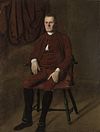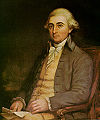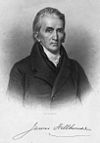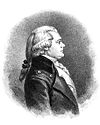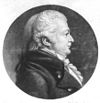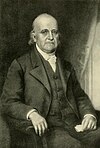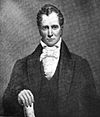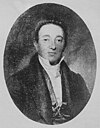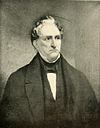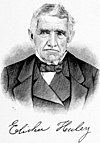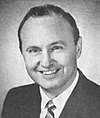Congress and years Seat A Seat B Seat C Seat D Seat E Seat F Seat G Rep. Party Electoral history Rep. Party Electoral history Rep. Party Electoral history Rep. Party Electoral history Rep. Party Electoral history Rep. Party Electoral history Rep. Party Electoral history 1st March 4, 1789 – Benjamin Huntington (Norwich ) Pro-Admin Elected in 1788 . Roger Sherman (New Milford ) Pro-Admin Elected in 1788 .Re-elected in 1790 , [ 1] but instead resigned to become U.S. Senator . Jonathan Sturges (Fairfield ) Pro-Admin Elected in 1788 .Re-elected in 1790 .Re-elected in 1792 but declined to serve. Jonathan Trumbull Jr. (Lebanon ) Pro-Admin Elected in 1788 .Re-elected in 1790 .Re-elected in 1792 .Re-elected in 1794 but declined to serve when instead elected U.S. Senator. Jeremiah Wadsworth (Hartford ) Pro-Admin Elected in 1788 .re-elected in 1790 to finish the term of Pierpont Edwards (Pro-Administration), who had declined to serve.Re-elected again in 1790 .Re-elected in 1792 . Seat created in 1793. Seat created in 1793. 2nd March 4, 1791 – James Hillhouse (New Haven ) Pro-Admin Elected in 1790 .Re-elected in 1792 .Re-elected in 1794 . Amasa Learned (New London ) Pro-Admin Elected to finish Sherman's term .Re-elected in 1792 . 3rd March 4, 1793 – Joshua Coit (New London ) Pro-Admin Elected in 1792 .Re-elected in 1794 .Re-elected in 1796 . Zephaniah Swift (Windham ) Pro-Admin Elected in 1792 .Re-elected in 1794 .Re-elected in 1796 but declined to serve. Uriah Tracy (Litchfield ) Pro-Admin Elected in 1792 .Re-elected in 1794 . 4th March 4, 1795 – Federalist Chauncey Goodrich (Hartford ) Federalist Elected in 1794 .Re-elected in 1796 .Re-elected in 1798 . Federalist Vacant Nathaniel Smith (Woodbury ) Federalist Elected in 1794 .Elected in 1796 . Federalist Federalist April 13, 1795 – Roger Griswold (Lyme ) Federalist Elected to finish Trumbull's term .Re-elected in 1796 .Re-elected in 1798 .Re-elected in 1800 .Re-elected in 1802 .Re-elected in 1804 but resigned. October 13, 1796 – Vacant December 5, 1796 – James Davenport (Stamford ) Federalist Elected to finish Hillhouse's term , having already been elected to the next term, see below.Elected in 1796 . January 3, 1797 – Samuel W. Dana (Middletown ) Federalist Elected to finish Tracy's term .Re-elected in 1796 .Re-elected in 1798 .Re-elected in 1800 .Re-elected in 1802 .Re-elected in 1804 .Re-elected in 1806 .Re-elected in 1808 . 5th March 4, 1797 – John Allen (Litchfield ) Federalist Elected to finish Swift's term. August 3, 1797 – Vacant November 13, 1797 – William Edmond (Newtown ) Federalist Elected to finish Davenport's term .Re-elected in 1798 . September 5, 1798 – Vacant December 3, 1798 – Jonathan Brace (Hartford ) Federalist Elected in 1798 .Later elected to finish Coit's term . 6th March 4, 1799 – Elizur Goodrich (New Haven )
Federalist Elected in 1798 .Re-elected in 1800 but declined to serve. John Davenport (Stamford ) Elected in 1798 .Re-elected in 1800 .Re-elected in 1802 .Re-elected in 1804 .Re-elected in 1806 .Re-elected in 1808 .Re-elected in 1810 .Re-elected in 1812 .Re-elected in 1814 . ? 1800 –Vacant November 17, 1800 – John Cotton Smith (Sharon ) Federalist Elected to finish Brace's term .Elected in 1800 to the next term .Re-elected in 1802 .Re-elected in 1804 . 7th March 4, 1801 – Vacant Elias Perkins (New London ) Federalist Elected in 1800 .Re-elected in 1802 but declined to serve. Vacant May 14, 1801 – Calvin Goddard (Plainfield ) Federalist Elected to finish Goodrich's term .Re-elected in 1802 .Re-elected in 1804 but resigned. September 21, 1801 – Benjamin Tallmadge (Litchfield ) Federalist Elected to finish Edmond's term .Re-elected in 1802 .Re-elected in 1804 .Re-elected in 1806 .Re-elected in 1808 .Re-elected in 1810 .Re-elected in 1812 .Re-elected in 1814 . 8th March 4, 1803 – Simeon Baldwin (New Haven ) Federalist Elected to finish Perkins's term . 9th March 4, 1805 – Jonathan O. Moseley (East Haddam ) Federalist Elected in 1804 .Re-elected in 1806 .Re-elected in 1808 .Re-elected in 1810 .Re-elected in 1812 .Re-elected in 1814 .Re-elected in 1816 .Re-elected in 1818 as a Democratic-Republican. ?before September 16, 1805 – Vacant Vacant September 16, 1805 – Timothy Pitkin (Farmington ) Federalist Elected to finish Griswold's term .Re-elected in 1806 .Re-elected in 1808 .Re-elected in 1810 .Re-elected in 1812 .Re-elected in 1814 .Re-elected in 1816 . Lewis B. Sturges (Fairfield ) Federalist Elected to finish Goddard's term .Re-elected in 1806 .Re-elected in 1808 .Re-elected in 1810 .Re-elected in 1812 .Re-elected in 1814 . August 1806 – Vacant December 1, 1806 – Theodore Dwight (Hartford ) Federalist Elected to finish Smith's term . 10th March 4, 1807 – Epaphroditus Champion (East Haddam ) Federalist Elected in 1806 .Re-elected in 1808 .Re-elected in 1810 .Re-elected in 1812 .Re-elected in 1814 . 11th March 4, 1809 – May 10, 1810 – Vacant October 11, 1810 – Ebenezer Huntington (Norwich ) Federalist Elected September 17, 1810, to finish Dana's term (seated October 11, 1810). 12th March 4, 1811 – Lyman Law (New London ) Federalist Elected in 1810 .Re-elected in 1812 .Re-elected in 1814 . 13th March 4, 1813 – 14th March 4, 1815 – 15th March 4, 1817 – Thomas Scott Williams (Hartford ) Federalist Elected in 1816 . Uriel Holmes (Litchfield ) Federalist Elected in 1816 . Samuel B. Sherwood (Saugatuck ) Federalist Elected in 1816 . Nathaniel Terry (Hartford ) Federalist Elected to finish the term of member-elect Charles Dennison, who had declined the seat . Ebenezer Huntington (Norwich ) Federalist Elected to finish the term of member-elect Sylvanus Backus, who had died . ? 1818 –Vacant November 16, 1818 – Sylvester Gilbert (Hebron ) Democratic-Republican Elected to finish Holmes's term . 16th March 4, 1819 – Gideon Tomlinson (Fairfield ) Democratic-Republican Elected in 1818 .Re-elected in 1821 .Re-elected in 1823 .Re-elected in 1825 . Democratic-Republican Samuel A. Foot (Cheshire ) Democratic-Republican Elected in 1818 . John Russ (Hartford ) Democratic-Republican Elected in 1818 .Re-elected in 1821 . James Stevens (Stamford ) Democratic-Republican Elected in 1818 . Elisha Phelps (Simsbury ) Democratic-Republican Elected in 1818 . Henry W. Edwards (New Haven ) Democratic-Republican Elected in 1818 .Re-elected in 1821 . 17th March 4, 1821 – Ansel Sterling (Sharon ) Democratic-Republican Elected in 1821 .Re-elected in 1823 . Daniel Burrows (Hebron ) Democratic-Republican Elected in 1821 . Noyes Barber (Groton ) Democratic-Republican Elected in 1821 .Re-elected in 1823 .Re-elected in 1825 .Re-elected in 1827 .Re-elected in 1829 .Re-elected in 1831 .Re-elected in 1833 . Ebenezer Stoddard (Woodstock ) Democratic-Republican Elected in 1821 .Re-elected in 1823 . 18th March 4, 1823 – Samuel A. Foot (Cheshire ) Democratic-Republican Elected in 1823 . Lemuel Whitman (Farmington ) Democratic-Republican Elected in 1823 . Seat eliminated in 1823. 19th March 4, 1825 – Anti-Jacksonian John Baldwin (Windham ) Anti-Jacksonian Elected in 1825 .Re-elected in 1827 . Ralph I. Ingersoll (New Haven ) Anti-Jacksonian Elected in 1825 .Re-elected in 1827 .Re-elected in 1829 .Re-elected in 1831 . Orange Merwin (New Milford ) Anti-Jacksonian Elected in 1825 .Re-elected in 1827 . Anti-Jacksonian Elisha Phelps (Simsbury ) Anti-Jacksonian Elected in 1825 .Re-elected in 1827 . 20th March 4, 1827 – David Plant (Stratford ) Anti-Jacksonian Elected in 1827 . 21st March 4, 1829 – William W. Ellsworth (Hartford ) Anti-Jacksonian Elected in 1829 .Re-elected in 1831 .Re-elected in 1833 . Jabez W. Huntington (Litchfield ) Anti-Jacksonian Elected in 1829 .Re-elected in 1831 .Re-elected in 1833 .Connecticut Supreme Court of Errors . Ebenezer Young (Killingly Center ) Anti-Jacksonian Elected in 1829 .Re-elected in 1831 .Re-elected in 1833 . William L. Storrs (Middletown ) Anti-Jacksonian Elected in 1829 .Re-elected in 1831 .[ data missing ] 22nd March 4, 1831 – 23rd March 4, 1833 – Samuel A. Foot (Cheshire ) Anti-Jacksonian Elected in 1833 .Governor of Connecticut . Samuel Tweedy (Danbury ) Anti-Jacksonian Elected in 1833 . May 9, 1834 – Vacant July 8, 1834 – Vacant August 16, 1834 – Vacant December 1, 1834 – Joseph Trumbull (Hartford ) Anti-Jacksonian Elected to finish Ellsworth's term . Phineas Miner (Litchfield ) Anti-Jacksonian Elected to finish Huntington's term . Ebenezer Jackson Jr. (Middletown ) Anti-Jacksonian Elected to finish Foot's term . 24th March 4, 1835 – Isaac Toucey (Hartford ) Jacksonian Elected in 1835 . 1st district . Samuel Ingham (Saybrook ) Jacksonian Elected in 1835 . 2nd district . Elisha Haley (Mystic ) Jacksonian Elected in 1835 . 3rd district . Zalmon Wildman (Danbury ) Jacksonian Elected in 1835 . Lancelot Phelps (Hitchcockville ) Jacksonian Elected in 1835 . 5th district . Andrew T. Judson (Canterbury ) Jacksonian Elected in 1835 .U.S. District Judge . December 10, 1835 – Vacant April 29, 1836 – Thomas T. Whittlesey (Danbury ) Jacksonian Elected to finish Wildman's term . 4th district . July 4, 1836 – Vacant December 5, 1836 – Orrin Holt (Willington ) Jacksonian Elected to finish Judson's term . 6th district . 


